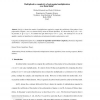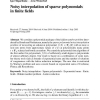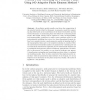561 search results - page 6 / 113 » Using number fields to compute logarithms in finite fields |
SYMMETRY
2010
13 years 3 months ago
2010
: The theory of elasticity is used to predict the response of a material body subject to applied forces. In the linear theory, where the displacement is small, the stress tensor wh...
CSR
2006
Springer
14 years 3 days ago
2006
Springer
Let Mq (n ) denote the number of multiplications required to compute the coefficients of the product of two polynomials of degree n over a q -element field by means of bilinear alg...
AAECC
2005
Springer
13 years 8 months ago
2005
Springer
Abstract We consider a polynomial analogue of the hidden number problem introduced by Boneh andVenkatesan, namely the sparse polynomial noisy interpolation problem of recovering an...
ICCS
2004
Springer
14 years 1 months ago
2004
Springer
Air pollution models usually start from the computation of the velocity field of a fluid. In this paper, we present a model for computing that field based on the contribution of...
DCC
1999
IEEE
13 years 8 months ago
1999
IEEE
An important component of the index calculus methods for finding discrete logarithms is the acquisition of smooth polynomial relations. Gordon and McCurley (1992) developed a sieve...



